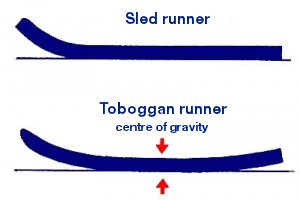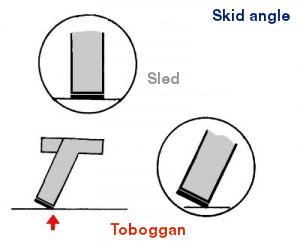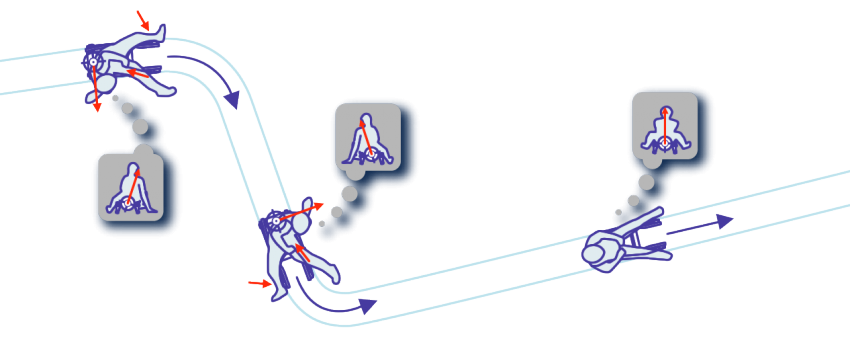tobogganing technique
How does a toboggan actually work?
The sled is cleverly designed. In contrast to toboggans such as Grindelwalder, Davoser, etc., the runners are slightly bent in the longitudinal direction and the trestles are movably connected to the runners (with rubber bearings) and not firmly glued as is the case with a sled. The laterally folded runners allow precise and safe steering. By shifting the weight and applying pressure to the corresponding skid and pulling on the steering rope, the geometry is changed so that the sled moves in the desired direction. Braking steering attempts with your feet in the snow are a thing of the past.
The curved runners also provide an optimum centre of gravity. This makes the rotational resistance smaller than with a slide and the manoeuvrability considerably greater. This means much better cornering performance than with a rigid sled.

In contrast to the sled, the runners of the sled are inclined on the inner edge. The friction resistance is lower, the guidance is much better and therefore the sled is lighter and easier to steer than a sled. Less frictional resistance also means that the gliding characteristics of a sled are much better and the speed is therefore much higher. The comfortable textile or plastic tarpaulin seats dampen bumps and protect the back.

The skid angle
This is mostly between 5° and 20° depending on the model. Most sport toboggans, however, are built with the maximum runner angle of 25° according to the regulations. The smaller the runner angle, the better the toboggan glides in the straight line on the snow. The larger the skid angle, the better the tracking in the curve and on ice. With 25°, for example, very high speeds are also possible. Whereby, on certain stretches, a sports sled with a 20° runner angle, for example, can also be faster on fresh snow.
How to steer a toboggan

A curve is approached from the outside. Shortly before the bend you straighten up, brake hard and take your feet up again. In a right-hand bend, hold the steering belt with your left hand and pull up the right runner; the right leg is lifted. This relieves the pelvis on the right (inside of the curve). There’s pressure on the left outer skid. The left leg is pressed in the direction of the curve against the left skid. In tight corners, the right arm is stretched out from behind, the shoulder puts pressure on the rear bar (and runner) and the right hand reaches into the snow. Just by lifting your knee, you can take slight bends.
brakes
For braking, the feet are placed close to the runners. We also recommend for recreational toboggan runners to put on sled soles or special shoes with brake fittings. With such equipment the emergency front lifting of the sled is not necessary. The more effective the braking, the lower the risk of accidents and the less time you lose. If you drive too fast in a curve, the toboggan slips behind you (drifting) and thus causes a strong loss of speed at the exit of the curve. Worst-case scenario, you get kicked out of a curve.
Rather drive a curve slowly and cleanly than uncontrolled and too fast
Care and storage tips
The toboggan is a piece of sports equipment and with a reasonable riding style and proper care it will give you pleasure for a long time.
- If necessary, grind steel rails in running direction with grain size 60-80.
- The icier the track, the finer the grinding of the rail.
- The inner edge of the rail should be sharp.
- After sanding with steel wool, pull off in running direction (remove sanding residues) and clean from sanding dust with wax remover.
- The structure must be clean in itself.
- The splints should be treated with 3R ORIGINAL DAVOSER wax products.
- After tobogganing, wipe the tracks dry and wax. Unfortunately, most good and fast rails are susceptible to rust.
- Do not expose the toboggan to the blazing sun in the car for long periods of time.
- When mounting the steel rails, ensure 1-2mm toe-in. Front slightly narrower than rear (like the track setting of a car)
The right storage
- Lightly oil or wax rails
- Store in a dry, cool place
- Freestanding or lying Storage
- Never lean against one side or load with objects
- Do not place device near radiators or other heat sources
Behavioural Tips
- Before you return to the inn, secure the toboggan against theft with a very short rope lock.
- Never stop in confusing curves.
- If you need to stop at a bend, go to the inside of the bend and / or warn the following toboggan runners of the danger.
- If you walk on a toboggan run, you march in a goose march and always in such a way that you can be seen.
- Do not overestimate your own ability and do not underestimate your own speed.
- Only drive so fast that you always have the toboggan safely under control.
- Brake briefly before tight bends and then turn into the bend.
- Do not ride a toboggan if you have drunk alcohol.
- Tobogganing doesn’t mean that you drive as fast as possible over the biggest bumps and you are surprised that the rams or poles break. A smart luge athlete drives fast, but with brains. No car driver would think of driving 120kmh fast on a dirt road with potholes and heels
- If you change to a toboggan you should drive carefully. For most people the toboggan doesn’t break in 30 years, but sometimes something goes wrong on the first rides because you overestimated yourself and / or didn’t have the right equipment. The absolute minimum for sledging and tobogganing are ski goggles for visibility and special shoes or soles for braking.
- Toboggans and sledges hold “forever” why actually? Those who toboggan quickly can also catch a pothole or “putsch” times in a snow hut most sleds and toboggans can withstand that. But sometimes an unspectacular “Putscher” or “Rempler” to the band can have been too much for the device. What, you buckled a pole? Sledge leg torn? If everything is not a problem, with us you can give everything to the repair. Quality products can always be repaired. Material defects are fortunately very, very rare.
Safety on sledges and bobsleds
There are reports in the media that tobogganing is much more dangerous than skiing. Let’s have a look at the people who go tobogganing and the people who go skiing. The skiers are equipped with helmet, ski goggles, ski boots, ski suit, gloves, etc… Skaters often go down steepest tracks without helmets and glasses and without appropriate tobogganing shoes or braking aids, without thinking about what can happen. That’s when the serious accidents happen. For example, sledders drive too fast into a bend, tip over and find everything so funny, because nobody can brake and even crash into the pile of screaming people. This attitude is absolutely stupid and extremely dangerous. If you tip over, you should clear the lane as quickly as possible and move to the edge of the lane. In addition, you should warn the following sledgemen, as seldom one is equipped in such a way that he can brake on a smooth track. There must be a general rethink.
Tobogganers and skaters must also be properly equipped: with ski goggles, braking aid on the feet, helmet, gloves, etc. This is the only way to reduce the risk and drive safely. In addition, you should always be able to stop within sight by toboggan or sledge. Think not only of yourselves but also of the others who lie or stop in the most confusing places and thus endanger themselves.
And finally: Alcohol is just as out of place for sledging as it is for driving a car!
Once again briefly the rules
- no alcohol
- good equipment
- braking aids on the boots
- helmet, ski goggles
- if you tip over with the sled, immediately clear the track
- warn the following sled runners
- only drive so fast that you can brake in time
Safety tips from the bfu
Safety tips from the Swiss Accident Prevention Advisory Centre bfu on the subject of tobogganing and tobogganing.